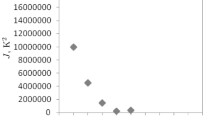Based on the analysis of direct variational methods used in the Hilbert space — the regularization method and the iterative regularization method — an iterative variational method was developed for regularization of the mathematically incorrect solution of nonlinear inverse thermoelasticity problems described by partial differential equations. Using the quadratic functional of the regularization method, an integral equation of the first kind is obtained, which connects the norms of increments of the direct and inverse thermoelasticity problems. The solution of the inverse problem is linearized by calculating the norms in the Hilbert space of square-integrable functions. The integral equation is regularized by reducing it to the Euler equation. The discretization of the boundary-value problem, described by the Euler equation, is performed, and the resulting system of linear algebraic equations is solved. A computational experiment was carried out for the simultaneous identification of two nonlinear temperature functions that confirms the efficiency of the method and shows that in the iterative selection of a quasi-solution for simultaneous determination of several functions, one experimental mode can be used.
Similar content being viewed by others
References
K. Rektorys, Variational Methods in Mathematics, Science and Engineering [Russian translation], Mir, Moscow (1985).
A. N. Tikhonov and V. Ya. Arsenin, Methods for Solving Ill-Posed Problems [in Russian], Nauka, Moscow (1979).
O. M. Alifanov, Inverse Problems of Heat Transfer [in Russian], Mashinostrienie, Moscow (1988).
M. R. Romanovskii, Mathematical modeling of experiments with the help of inverse problems, J. Eng. Phys. Thermophys., 57, No. 2, 1112–1117 (1989).
M. R. Romanovskii, Planning an experiment for mathematical model identification, J. Eng. Phys. Thermophys., 58, No. 6, 800–807 (1990).
Author information
Authors and Affiliations
Corresponding author
Additional information
Translated from Inzhenerno-Fizicheskii Zhurnal, Vol. 96, No. 5, pp. 1123–1134, September–October, 2023.
Rights and permissions
Springer Nature or its licensor (e.g. a society or other partner) holds exclusive rights to this article under a publishing agreement with the author(s) or other rightsholder(s); author self-archiving of the accepted manuscript version of this article is solely governed by the terms of such publishing agreement and applicable law.
About this article
Cite this article
Vikulov, A.G. Uniqueness and Stability of Solving the Inverse Problem of Thermoelasticity. Part 2. Regularization. J Eng Phys Thermophy 96, 1117–1127 (2023). https://doi.org/10.1007/s10891-023-02776-z
Received:
Published:
Issue Date:
DOI: https://doi.org/10.1007/s10891-023-02776-z



